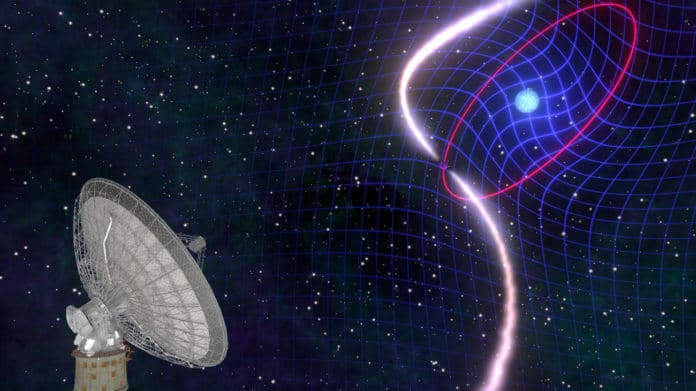Frame dragging is a predicted phenomenon in general relativity, whereby a rotating mass drags the surrounding spacetime around with it. After almost 20 years of patient monitoring, an international team of astronomers has witnessed the dragging of space-time around a rapidly-rotating exotic star known as a white dwarf.
Stars are born within the clouds of dust and scattered throughout most galaxies. Most massive stars are born in pairs, and at the end of their lives, they leave behind super-dense cores in the form of a white dwarf, neutron star, or black hole. Neutron stars transmit regular clock-like pulses that empower astronomers to map their orbits to outstanding exactness.
Dr. Ramesh Bhat from the Curtin University node of ICRAR said, “This is an exotic stellar pair in which a tiny, super-dense neutron star the size of Perth orbits another compact Earth-sized white dwarf star five times a day; both have masses about the same as our own Sun. It took 20 years of patient monitoring and scrutiny of data to figure out what is going on.”
Scientists started mapping the orbit in a series of intensive observing campaigns at CSIRO’s Parkes 64-metre radio telescope. Throughout the following two decades, it became apparent that the stars’ motion required Einstein’s General Theory of Relativity to clarify their intricate dance.
Lead author, Max Planck Institute for Radio Astronomy’s (MPIfR) Vivek Venkatraman Krishnan (VVK), took up the challenge of unwinding the many intertwined Einsteinian impacts at play.
VVK said, “At first the stellar pair appeared to exhibit many of the classic effects that Einstein’s theory predicted. We then noticed a gradual change in the orientation of the plane of the orbit.”
MPIfR’s Dr. Paulo Freire postulated that “this might be, at least in part, due to the so-called “frame-dragging” that all matter is subject to in the presence of a rotating body as predicted by the Austrian mathematicians Lense and Thirring in 1918.”
Danish theorist Professor Thomas Tauris (Aarhus University) said, “In a stellar pair, the first star to collapse is often rapidly rotating due to subsequent mass transfer from its companion. Our simulations helped quantify the magnitude of the white dwarf’s spin. In this system, the entire orbit is being dragged around by the white dwarf’s spin, which is misaligned with the orbit.”
MPIfR’s Dr. Norbert Wex said, “One of the first confirmations of frame-dragging used four gyroscopes in a satellite in orbit around the Earth, but in our system, the effects are 100 million times stronger.”
ICRAR’s Dr. Ramesh Bhat says that the effect makes the pulsar’s orbit tumble in space. “It provides yet another stunning confirmation of Einstein’s theory, which continues to shine in brilliance even after a century of its formulation. I find it truly fascinating.”
The results of the study are published in Science.
